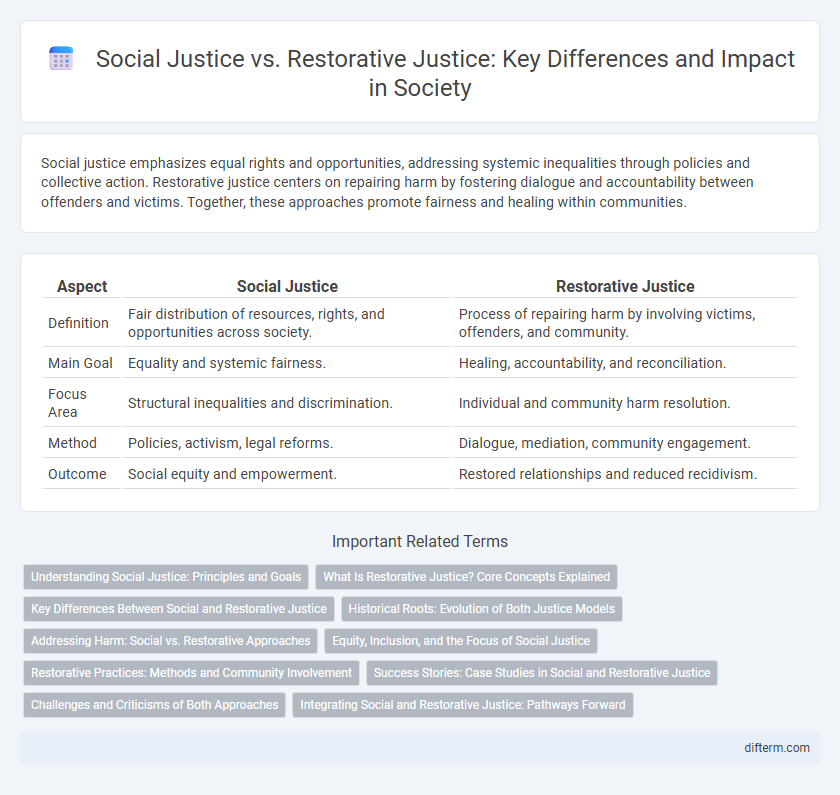Social justice emphasizes equal rights and opportunities, addressing systemic inequalities through policies and collective action. Restorative justice centers on repairing harm by fostering dialogue and accountability between offenders and victims. Together, these approaches promote fairness and healing within communities.
Table of Comparison
| Aspect | Social Justice | Restorative Justice |
|---|---|---|
| Definition | Fair distribution of resources, rights, and opportunities across society. | Process of repairing harm by involving victims, offenders, and community. |
| Main Goal | Equality and systemic fairness. | Healing, accountability, and reconciliation. |
| Focus Area | Structural inequalities and discrimination. | Individual and community harm resolution. |
| Method | Policies, activism, legal reforms. | Dialogue, mediation, community engagement. |
| Outcome | Social equity and empowerment. | Restored relationships and reduced recidivism. |
Understanding Social Justice: Principles and Goals
Social justice centers on ensuring equitable distribution of resources, opportunities, and rights for all individuals, aiming to dismantle systemic inequalities and promote fairness within society. It emphasizes the protection of marginalized groups through policies that address discrimination, poverty, and access to education and healthcare. The core goals of social justice include achieving equality, enhancing social inclusion, and fostering a climate of respect and human dignity across diverse communities.
What Is Restorative Justice? Core Concepts Explained
Restorative justice emphasizes repairing harm caused by criminal behavior through inclusive processes that engage victims, offenders, and the community. Core concepts include accountability, healing, and dialogue, prioritizing the restoration of relationships over punishment. This approach fosters empathy, promotes rehabilitation, and supports community cohesion by addressing the underlying causes of conflict.
Key Differences Between Social and Restorative Justice
Social justice emphasizes broader systemic equality by addressing issues like poverty, discrimination, and access to resources, seeking widespread societal reform. Restorative justice centers on repairing harm caused by specific offenses through reconciliation between victims, offenders, and communities, promoting healing and accountability. The key differences lie in social justice's focus on structural change versus restorative justice's personalized approach to conflict resolution and restoration.
Historical Roots: Evolution of Both Justice Models
Social justice emerged from 19th-century movements advocating for equitable distribution of resources and protection of marginalized groups, influenced by industrialization and labor rights struggles. Restorative justice evolved from indigenous and community-based traditions emphasizing healing, accountability, and reconciliation rather than punishment. The historical roots of these justice models reflect distinct approaches: social justice focuses on systemic equity, while restorative justice centers on repairing harm and restoring relationships.
Addressing Harm: Social vs. Restorative Approaches
Social justice addresses harm by focusing on systemic inequalities and advocating for policy reforms to ensure equity and rights for marginalized communities. Restorative justice prioritizes healing and dialogue between victims and offenders to repair relationships and foster accountability on a personal level. Both approaches aim to correct harm but differ fundamentally in their methods and scale of intervention.
Equity, Inclusion, and the Focus of Social Justice
Social justice emphasizes equity and inclusion by addressing systemic inequalities and ensuring fair distribution of resources among marginalized communities. Restorative justice focuses on repairing harm and fostering reconciliation between offenders and victims through inclusive dialogue and community involvement. Both approaches prioritize empowering individuals and creating environments where diverse identities are respected and supported.
Restorative Practices: Methods and Community Involvement
Restorative practices emphasize community involvement by facilitating dialogue circles, victim-offender mediation, and collaborative problem-solving to repair harm and rebuild trust. These methods prioritize accountability, empathy, and mutual respect, fostering healing rather than punishment. Community stakeholders collaborate in decision-making processes to create inclusive environments that address root causes of conflict and promote social cohesion.
Success Stories: Case Studies in Social and Restorative Justice
Case studies in social and restorative justice highlight transformative success stories where marginalized communities achieve empowerment and reconciliation through inclusive dialogue and accountability. Key examples include the South African Truth and Reconciliation Commission, which facilitated healing after apartheid, and community-based restorative programs in juvenile justice that reduce recidivism by fostering offender accountability and victim restitution. These successes demonstrate how restorative justice approaches complement social justice goals by promoting repair over punishment and building stronger, more equitable societies.
Challenges and Criticisms of Both Approaches
Social justice faces challenges such as systemic inequality and difficulty addressing immediate harms, while restorative justice is criticized for potentially minimizing accountability and being less effective in addressing deep-rooted social structures. Both approaches struggle with balancing individual needs and broader societal change, often facing resistance from entrenched legal and political systems. Effective integration requires overcoming skepticism about their efficacy and ensuring inclusive participation from marginalized communities.
Integrating Social and Restorative Justice: Pathways Forward
Integrating social justice and restorative justice creates a comprehensive framework that addresses systemic inequalities while promoting healing and accountability in communities. Emphasizing reparative actions and equitable resource distribution fosters empowerment for marginalized groups and mitigates cycles of harm. This pathway forward demands collaborative policymaking, inclusive dialogue, and sustained commitment to transformative change at institutional and grassroots levels.
social justice vs restorative justice Infographic

 difterm.com
difterm.com